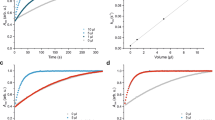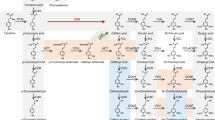Abstract
Catechol oxidases are ubiquitous plant enzymes containing a dinuclear copper center. In the wound-response mechanism of the plant they catalyze the oxidation of a broad range of ortho-diphenols to the corresponding o-quinones coupled with the reduction of oxygen to water. The crystal structures of the enzyme from sweet potato in the resting dicupric Cu(II)-Cu(II) state, the reduced dicuprous Cu(I)-Cu(I) form, and in complex with the inhibitor phenylthiourea were analyzed. The catalytic copper center is accommodated in a central four-helix-bundle located in a hydrophobic pocket close to the surface. Both metal binding sites are composed of three histidine ligands. His 109, ligated to the CuA site, is covalently linked to Cys 92 by an unusual thioether bond. Based on biochemical, spectroscopic and the presented structural data, a catalytical mechanism is proposed in which one of the oxygen atoms of the diphenolic substrate binds to CuB of the oxygenated enzyme.
This is a preview of subscription content, access via your institution
Access options
Subscribe to this journal
Receive 12 print issues and online access
$189.00 per year
only $15.75 per issue
Buy this article
- Purchase on Springer Link
- Instant access to full article PDF
Prices may be subject to local taxes which are calculated during checkout






Similar content being viewed by others
References
Karlin, K. D. Metalloenzymes, structural motifs, and inorganic models. Science 261, 701–708 (1993).
Solomon, E. I., Sundaram, U. M. & Machonkin, T. E. Multicopper oxidases and oxygenases. Chem. Rev. 96, 2563–2605 (1996).
Magnus, K. A., Ton-That, H. & Carpenter, J. E. Recent structural work on the oxygen transport protein hemocyanin. Chem. Rev. 94, 727–735 (1994).
Eicken, C., Zippel, F., Büldt-Karentzopoulos, K. & Krebs, B. Biochemical and spectroscopic characterization of catechol oxidase from sweet potatoes (Ipomoea batatas) containing a type-3 dicopper center. FEBS Lett. 436, 293–299 (1998).
Lerch, K. Neurospora tyrosinase: structural, spectroscopic and catalytic properties. Mol. Cell. Biochem. 52, 125–138 (1983).
Cary, J. W., Lax, A. R. & Flurkey, W. H. Cloning and characterization of cDNAs coding for Vicia faba polyphenol oxidase. Plant Mol. Biol. 20, 245–253 (1992).
Dervall, B. J. Phenolase and pectic enzyme activity in the chocolate spot disease of beans. Nature 189, 311 (1961).
Rompel, A. et al. Spectroscopic and EXAFS studies on catechol oxidases with dinuclear copper centers of type 3: evidence for μ-η2: η2-peroxo-intermediates during the reaction with catechol. J. Inorg. Biochem. 59,–715 (1995).
Ito, N. et al. Novel thioether bond revealed by a 1.7 Å crystal structure of galactose oxidase. Nature 350, 87–90 (1991).
Lerch, K. Primary structure of tyrosinase from Neurospora crassa. II. Complete amino acid sequence and chemical structure of a tripeptide containing an unusual thioether. J. Biol. Chem. 257, 6414–6419 (1982).
Gielens, C. et al. Evidence for a cysteine-histidine thioether bridge in functional units of molluscan haemocyanins and location of the disulfide bridges in functional units d and g of the betaC-haemocyanin of Helix pomatia. Eur. J. Biochem. 248, 879–888 (1997).
Miller, K. I. et al. Sequence of the Octopus dofleini hemocyanin subunit: structural and evolutionary implications. J. Mol. Biol. 278, 827–842 (1998).
Cuff, M. E., Miller, K. I., van Holde, K. E. & Hendrickson, W.A. Crystal structure of a functional unit from octopus hemocyanin. J. Mol. Biol. 278, 855–870 (1998).
Gaykema, W. P. J et al. 3.2 Å structure of the copper-containing, oxygen-carrying protein Panulirus interruptus haemocyanin. Nature 309, 23–29 (1984).
Volbeda, A. & Hol, W. G. J. Crystal structure of hexameric haemocyanin from Panulirus interruptus refined at 3.2 A resolution. J. Mol. Biol. 209, 249–279 (1989).
Hazes, B. et al. Crystal structure of deoxygenated Limulus polyphemus subunit II hemocyanin at 2.18 A resolution: clues for a mechanism for allosteric regulation. Prot. Sci. 2, 576–619 (1993).
Wilcox, D. E. et al. Substrate analogue binding to the coupled binuclear copper active site in tyrosinase. J. Am. Chem. Soc. 107, 4015–4027 (1985).
Solomon, E. I., Sundaram, U. M. & Machonkin, T. E. Multicopper oxidases and oxygenases. Chem. Rev. 96, 2563–2605 (1996).
Magnus, K.A. et al. Crystallographic analysis of oxgyenated and deoxygenated states of arthropod hemocyanin shows unusual differences. Proteins 19, 302–309 (1994).
Himmelwright, R. S., Eickman, N. C., LuBien, C. D. & Lerch, K. and Solomon, E. I. Chemical and spectroscopic studies of the binuclear copper active site of Neurospora tyrosinase: comparison to hemocyanins. J. Am. Chem. Soc. 102, 7339–7344 (1980).
Jackman, M.P., Hajnal, A. & Lerch, K. Albino mutants of Streptomyces glaucescens tyrosinase. Biochem. J. 274, 707–713 (1991).
Otwinowski, Z. Oscillation Data Reduction Program. In Proceedings of the CCP4 study weekend: data collection and processing (eds Sawyer, L., Isaacs, N., Bailey, S.) 56–62 (SERC Daresbury Laboratory, Warrington, UK; 1993).
Furey,W. & Swaminathan, S. PHASES. A program package for processing and analysis of diffraction data from macromolecules. Meth. Enz. 277, 590–620 (1995).
Collaborative Computational Project Number 4. The CCP4 suite: programs for protein crystallography. Acta Crystallogr. D 50, 760-763 (1994).
de La Fortelle, E. & Bricogne, G. Meth. Enz. 276, 472–494.
Cowtan, K. D. & Main, P. Phase combination and cross validation in iterated density-modification calculations. Acta Crystallogr. D 52, 43–48 (1996).
Jones, T. A., Zou, J.-Y., Cowan, S. W. & Kjeldgaard, M. Improved methods for building protein models in electron density maps and the location of errors in these models. Acta Crystallogr. A 47, 110–119 (1991).
Brünger, A. T., Kuriyan, J. & Karplus, M. Crystallographic R factor refinement by molecular dynamics. Science 235, 458–460 (1987).
Navaza, J. AMoRe: an automated package for molecular replacement. Acta Crystallogr. A 50, 157–163 (1994).
Evans, S. V. SETOR: hardware lighted three-dimensional solid model representations of macromolecules. J. Mol. Graphics 11, 134–138 (1993).
Christopher, J. A. SPOCK: The structural properties observation and calculation kit (program manual). the center for macromolecular design. (Texas A&M University, College Station, Texas, USA;1998).
Brünger, A. T. Free R value: a novel statistical quantity for assessing the accuracy of crystal structures. Nature 355, 472–475 (1992).
Acknowledgements
Supported by the Deutsche Forschungsgemeinschaft, the Fonds der Chemischen Industrie, the Welch Foundation, and the NIH. T.K. thanks the Deutsche Forschungsgemeinschaft for a postdoctoral fellowship. We thank N. Sträter for reviewing the manuscript and V. L. Pecoraro for many helpful discussions. We all express our appreciation to the late Herbert Witzel for his commitment and contributions to this science. This study is in partial fulfillment of the requirements of C.E. for the degree of Dr. rer. nat. at the Westfälische Wilhelms-Universität Münster.
Author information
Authors and Affiliations
Corresponding authors
Rights and permissions
About this article
Cite this article
Klabunde, T., Eicken, C., Sacchettini, J. et al. Crystal structure of a plant catechol oxidase containing a dicopper center. Nat Struct Mol Biol 5, 1084–1090 (1998). https://doi.org/10.1038/4193
Received:
Accepted:
Issue Date:
DOI: https://doi.org/10.1038/4193
This article is cited by
-
An intramolecular macrocyclase in plant ribosomal peptide biosynthesis
Nature Chemical Biology (2024)
-
Discovery and biosynthesis of tricyclic copper-binding ribosomal peptides containing histidine-to-butyrine crosslinks
Nature Communications (2023)
-
Molecular insights of nanozymes from design to catalytic mechanism
Science China Chemistry (2023)
-
Biochemical characterization of Dimocarpus longan polyphenol oxidase provides insights into its catalytic efficiency
Scientific Reports (2022)
-
Plastid role in phytomelanin synthesis in Piptocarpha axillaris (Less.) Baker stems (Asteraceae, Vernonieae)
Protoplasma (2021)



